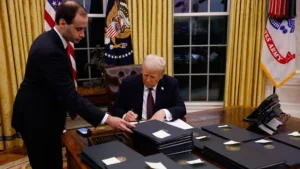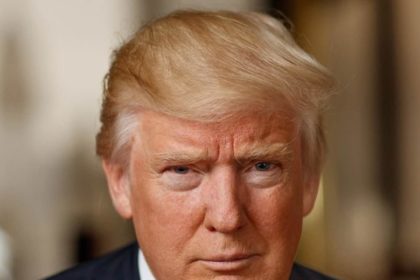
By Adeyemi Adekunle
President Donald Trump has wasted no time reestablishing the controversial policies of his previous administration, signing an executive order to commence the United States’ withdrawal from the World Health Organization (WHO). Trump’s decision, made mere hours after his inauguration, sends shockwaves through public health sectors worldwide, reigniting debates about global health cooperation and American leadership.
During a ceremonial signing in the Oval Office, Trump called the withdrawal a necessity, referencing the WHO’s handling of the Covid-19 pandemic. “Oooh, that’s a big one,” he quipped while putting his signature on the document. The move marks the second time the U.S. has sought to leave the WHO under his leadership, following his initial attempt in 2020. The withdrawal process was set to take effect in July 2021. But was later reversed by President Joe Biden same year.
Trump’s executive order accuses the WHO of mismanagement during the pandemic and failure to enact meaningful reforms. It claims that the organization displayed “inappropriate political influence” from member states, particularly China, and held it accountable for its guidance during the global health crisis. Trump had frequently criticized the WHO for being “China-centric” during his first administration, blaming it for delaying pandemic responses and obscuring the origins of the virus in Wuhan.
“They wanted us back so badly, so we’ll see what happens,” Trump remarked, hinting at possible future reconsideration. However, experts argue that a U.S. withdrawal could severely undermine global health initiatives and diminish America’s influence in international health governance.
The U.S., historically the largest donor to the WHO, contributed nearly 20% of the agency’s $6.8 billion annual budget as of 2023. Public health advocates worry that the financial void left by the U.S. could destabilize programs tackling diseases like malaria, tuberculosis, and HIV/AIDS. Without American funding and technical support, these initiatives may face significant setbacks, particularly in resource-constrained regions.
Ashish Jha, the former Covid-19 response coordinator under Biden, criticized the decision, stating, “This move will harm not only global health but also America’s standing and scientific leadership.” Similarly, Lawrence Gostin, a global public health expert at Georgetown University, described it as “a grievous wound to world health and a deeper wound to the U.S.”
The ramifications of the withdrawal extend beyond funding concerns. Experts warn that leaving the WHO could hinder global cooperation during future pandemics. The organization plays a critical role in disease surveillance, vaccine distribution, and setting health standards across member nations. Trump’s decision, therefore, signals a step away from collective action, potentially isolating the U.S. in moments of international health crises.
The executive order also highlights financial grievances, calling the U.S. contributions to the WHO “unfairly onerous” compared to other nations. Trump had previously pushed for a rebalancing of payments among member states, suggesting that countries like China should shoulder a greater share of funding responsibilities. While the order reiterates these concerns, critics argue that disengagement is a shortsighted solution that cedes global leadership to rival powers.
This latest move aligns with Trump’s broader “America First” agenda, which emphasizes national sovereignty over multilateral engagement. On the same day, Trump issued orders to leave the Paris Climate Agreement and prioritize domestic energy production, policies aimed at redirecting resources toward domestic concerns rather than global commitments.
However, the decision has drawn ire from international partners and American legislators alike. Democratic lawmakers, public health professionals, and foreign governments have expressed disappointment, warning of long-term repercussions. “Abandoning the WHO during a time of ongoing health challenges is reckless and shortsighted,” said a Senate Democrat.
Despite the criticism, Trump’s administration is pressing forward with the withdrawal process, setting a 12-month timeline for the U.S. to formally disengage. This timeline matches the notice period required under WHO regulations, giving the organization some time to adapt to the financial and operational impacts of the U.S. exit.
The WHO itself has not yet responded directly to Trump’s announcement but has previously expressed its desire to work collaboratively with all member states, including the U.S. Under Director-General Dr. Tedros Adhanom Ghebreyesus, the organization has pledged reforms to improve transparency and accountability—a move aimed at addressing criticisms raised during the pandemic.
While Trump’s decision may play well to his domestic base, who favor policies that prioritize national interests, public health experts emphasize the need for international solidarity. The interconnected nature of global health challenges demands cooperation, they argue, not isolationism. The withdrawal also raises concerns about the U.S.’s ability to effectively tackle cross-border health threats, which could eventually pose risks to American citizens.
Looking ahead, the move will undoubtedly shape how the U.S. engages with the international community on health matters. The Biden administration’s restoration of ties in 2021 underscored a commitment to global health partnerships, but Trump’s latest withdrawal reignites uncertainty about the U.S.’s role on the global stage. As the world grapples with ongoing health issues and prepares for future pandemics, the absence of U.S. leadership may leave a significant void.
Trump’s executive order presents more than just a policy change—it symbolizes a philosophical shift in how the U.S. views its responsibilities within multilateral institutions. Whether this approach ultimately benefits the nation or undermines its global standing remains to be seen.




